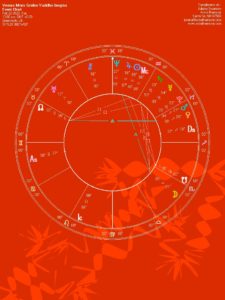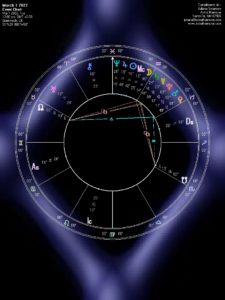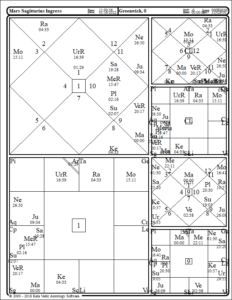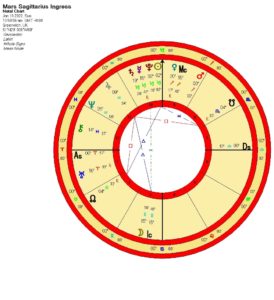 During this period, Mars (and Venus) in Sagittarius will trine Uranus in Aries, a fortunate aspect that will perfect (be exact) on February 8. Around this time, some of us may feel more daring, creative, and energized than usual, and may be looking to make some changes.
During this period, Mars (and Venus) in Sagittarius will trine Uranus in Aries, a fortunate aspect that will perfect (be exact) on February 8. Around this time, some of us may feel more daring, creative, and energized than usual, and may be looking to make some changes.
Here I am using a 3-degree applying and separating orb for transiting planets, so my calculation shows that Mars and Venus will be transiting in conjunction (close together in celestial longitude) from February 5 to March 22. They will be in Sagittarius until Mars moves to Capricorn February 26, and Venus into Capricorn February 27.
According to my calculations, Mars and Venus will be in graha yuddha (planetary war) from February 20 through March 3. A graha yuddha represents a potential conflict between any two planets among these five: Mars, Mercury, Venus, Jupiter, and Saturn. This conflict will manifest in the areas of life that these planets represent according to Vedic astrology. However, the way graha yuddha is calculated is controversial, meaning that astrologers and astrological systems differ in their opinions over the technical calculation for it, and also they differ over how it should be interpreted.
 Many astrologers just use the longitude to calculate graha yuddha, believing that as long as the two planets are within one degree of longitude, there will be a war. On the other hand, I calculate it based on visual conjunction, which takes into account more than just the planetary longitude but also includes other coordinates like declination, which is a measurement taken north and south of the celestial equator.
Many astrologers just use the longitude to calculate graha yuddha, believing that as long as the two planets are within one degree of longitude, there will be a war. On the other hand, I calculate it based on visual conjunction, which takes into account more than just the planetary longitude but also includes other coordinates like declination, which is a measurement taken north and south of the celestial equator.
The war between Mars and Venus is generally considered to be a mild one. However, on March 1-2, Saturn and Mercury will also be in a planetary war, so on those two days it may be especially important for us to lie low and be mindful as four planets will be in war. The conjunction (and especially the graha yuddha) between Mars and Venus reflects an overarching energy of “ambition” and “competition.” These energies can be either “good or bad,” i.e., either in healthy balance and alignment, or not. In any kind of war, there are always casualties, and Mars always loses to Venus in a planetary war because Venus is so much brighter, but Mars being a warrior doesn’t like to lose.
The conjunction (and especially the graha yuddha) between Mars and Venus reflects an overarching energy of “ambition” and “competition.” These energies can be either “good or bad,” i.e., either in healthy balance and alignment, or not. In any kind of war, there are always casualties, and Mars always loses to Venus in a planetary war because Venus is so much brighter, but Mars being a warrior doesn’t like to lose.
What does this mean? Well, in its lower expression, this Mars-Venus energy can suggest volatility in relationships, possessive feelings, obsessions and emotional attachments, materialistic desires out of control, and anger, conflict, and aggression. On a higher note, the Mars-Venus conjunction (and war) can represent highly goal-oriented, creative, and passionate qualities.
Where the planets are transiting and aspecting in our natal charts will determine how the transit will manifest for us individually. But in general, the Mars and Venus conjunction in Sagittarius (higher expression) can have quite a passionate, creative, and visionary flavor. It can be aspirational, idealistic, adventurous, and expansive, with an emphasis on humor, positivity, travel, learning, and wisdom. When they come together in Capricorn after leaving Sagittarius, they become more businesslike, down to earth, strategic, focused, mundane, and driven to create something in form.
In mythology, Venus represents beauty and love, and Mars signifies valor and passion, as depicted by the Italian Renaissance painter Sandro Botticelli in this allegorical panel painting of about 1485. It shows the youthful and voluptuous Roman gods Venus and Mars sensuously reclining in a forest setting surrounded by playful baby satyrs. Yet, they are lying across from each other, reflecting their opposite qualities; and note that Venus maintains the superior position, perhaps reminding us that pure love conquers all, and that we can and must rise above our base passions.



